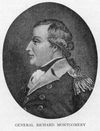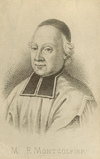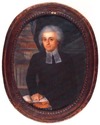got along well with the Roman Catholic clergy and members of the religious orders. Since no Anglican church had been erected he conducted services in the chapel of the Hôtel-Dieu. He maintained contact
Jesuits, Recollets, or Sulpicians. Murray’s wartime experience had not predisposed him towards the clergy: identifying them as “the source of all the mischiefs which have befallen the poor Canadians,” he
, these ideals took the form of opposition to the seigneurs, both French and English, to the clergy reserves, and to any attempt at censorship by either church or state. The Montreal Gazette
after the beginning of hostilities. Moreover, while the seigneurs, clergy, and bourgeoisie were almost uniformly loyal to the British thanks to the religious and legal guarantees contained in the Quebec
the pro-Americans who had recognized their error and had recanted in public through word or deed. A small number, however, refused to accept these conditions. For their part, the clergy seemed to be
Chartier* de Lotbinière, a Canadian, had been expected to get this important office, since the Canadian clergy felt it was time they were invited to take part in the administration of the church in
philosophes’ combat against intolerance, the abuses of the clergy, and the feudal system. The paper burst forth in exultation when the French revolution dawned, still borrowing news from its rival in
Séminaire des Missions Étrangères in Paris requesting the aid of French clergy with the Acadian missions.
Upon his arrival Le Roux was sent to
Murray when he was governor, as well as by the British authorities, who clearly favoured the Canadianization of the clergy, hoping in this way to hasten the breaking of all existing ties between
(St Matthew’s) Church, Gerrish undertook with Salter in 1770 to appeal for financial aid from large churches in Boston on behalf of the Congregational churches and clergy in Nova Scotia. The
clergy, who pretended to be unaware of the freemasons’ activities, were dumbfounded, and they envisaged the possibility of dismissing him as churchwarden, but Gamelin’s importance and his family’s
Briand, who had appealed to the clergy and the Canadian people to remain loyal.
On 15 Feb. 1776 the second Continental Congress in
Tory clergy of the revolution (New York, 1891). I. F. Mackinnon, Settlements and churches in Nova Scotia, 1749–1776 ([Montreal, 1930]). C. F. Pascoe, Two
by the people,” and relations between him and his clergy had become strained. Alleging that the air of his native land would do his health good, and that financial matters particularly required his
report.
The last, but by no means the least problem that had to be discussed with the authorities was the thorny one of giving the Canadian clergy a
Roman Catholicism. The quiet conversion of the Canadians by a respectable French-language Protestant clergy was such a measure. The Protestant merchants, disadvantaged in competition with the
, issued an open invitation to the French refugee clergy to settle in Canada. Castanet was among those who accepted. Approximately 45 French priests in exile left England for Canada between 1791 and 1802
occupied up till now by the king’s troops, and help it to begin again the charitable works which are the object of its rule.” This collection among the clergy and citizens of Quebec, inaugurated in March
publication of a weekly gazette. There were as many Canadian subscribers as there were British, most of the former being members of the clergy. On 21 June 1764 the first number of the Quebec
is now all but forgotten. He represents, however, that group of clergy, all chaplains, who served as a stopgap while the Church of England pondered the best pastoral approach to a colonial population








